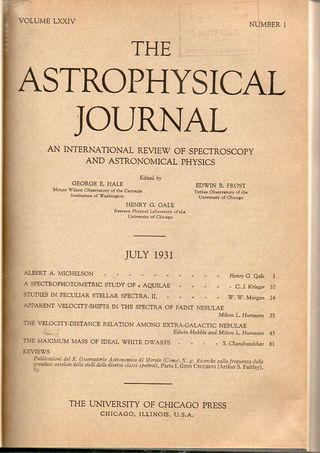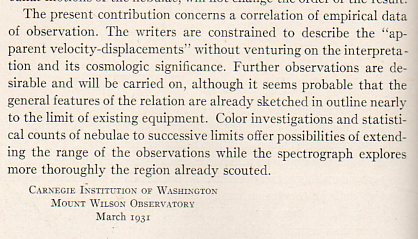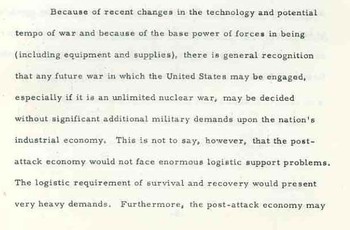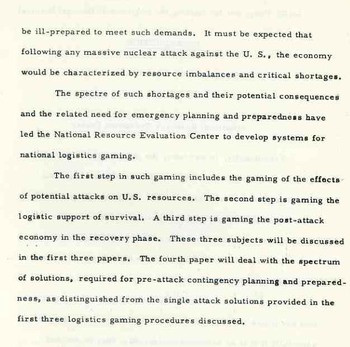JF Ptak Science Books Post 1748 (An expansion of an ealier post from 2008)
The soft-sell of the generally recognized and understood propositions, stepping well around the main, central, controlling issue, hinting broadly along its perimeters, defining the emptiness by its shell, left to an undistinguished recognition, is what we're hunting here.
I have two examples of extreme examples of understatement occurring at the beginning and end of things—all things.
The first understatement--"the" Big Bang of the title--that we will look at here belongs in the last paragraph of the seminal paper by Edwin Hubble and Milton Humason, writing an extension and refinement (and adding much more data) on the “discovery” of the Big Bang as they defined the Red Shift, which was actually a roughly proportional increase of distance traveled to red shift. They plotted a trend line for 46 galaxies and in 19291 formulated the empirical Redshift Distance Law of galaxies, which is today known as Hubble’s Law, which was consistent with the solutions of equations of GRT. (This momentous discovery was cheered by the normally non-cheering astronomy community in unusually verb-y ways, such as with the statement made by W.S. Adams, (director of the Mt. Wilson Observatory), who said that thee Hubble/Humason effort was "the most ambitious project astronomy has ever undertaken...maybe (the) research will reveal the very edge of the universe"2.
 It is in a further report on their studies in The Velocity-Distance Relation Among Extra-Galactic Nebulae (The Astrophysical Journal, July 1931, full text here) that Hubble and Humason react to and answer questions that arose from their 1929 paper, and also incorporate much new data. As a matter of fact, they managed to "spectacularly extend the linear relationship"3 to a speed of 20,000 kps, and also to an estimated distance of about 100 million light years, this by using many more points in the 1931 diagram. This was the further proof needed to strengthen the existence of a linear redshift-distance relation, and it appeared in this "promised sequel"4 of the 1931 paper.
It is in a further report on their studies in The Velocity-Distance Relation Among Extra-Galactic Nebulae (The Astrophysical Journal, July 1931, full text here) that Hubble and Humason react to and answer questions that arose from their 1929 paper, and also incorporate much new data. As a matter of fact, they managed to "spectacularly extend the linear relationship"3 to a speed of 20,000 kps, and also to an estimated distance of about 100 million light years, this by using many more points in the 1931 diagram. This was the further proof needed to strengthen the existence of a linear redshift-distance relation, and it appeared in this "promised sequel"4 of the 1931 paper.
It is in the 1931 paper that Hubble and Humason make their stupendous understatement: regarding their understanding of the phenomena and the expanding universe. They take many steps back, and say in the concluding paragraph "the writers are constrained to describe the apparent velocity-distance displacements without venturing on the interpretation and its cosmological significance". They basically lay out the functioning of the universe and the best understanding of how we got to where we are in the cosmos (Vesto Slipher notwithstanding), and how according to their understanding that the universe is expanding and is consistent with all known laws, that they decide to not say anything, um, philosophical.

And so, in the last paragraph of this paper discussing the Great Alpha, the authors decided, in their modest and terrifically understated Bartlebian way, to not comment.
The second example of tremendous understatement occurs in a report discussing the Great Omega, and how in the end the end might actually be avoided. Written by Joseph Coker, Chief of the National Resource Evaluation Center in the Office of Emergency Planning in Washington, D.C. in April 1965 (100 years to the month after the end of the U.S. Civil War), “NREC Programs for Gaming the Logistics of National Survival” is by its very title and appearance a startling looking and sounding document. Coker and his NREC worked within the Executive Office of the President (LBJ at the time), and his paper concentrated on a succinct appraisal of the existing gaming programs looking at survival of all aspects of the national life in the days following nuclear end-game.
In general the document is as dry and cardinal as bagel toast—it warms quickly and invisibly, however, and that bagel toast becomes a burnt and invisible cinder via Coker’s prose.
The document wastes no time in getting directly to vast understatement, and stays there. In chapter one “Logistics of National Survival”, the second chapter opens:
“Because of recent changes in the technology and potential tempo of war and because of the base power of force is in being (including equipment and supplies), there is general recognition that any future war in which the United States is engaged, especially if it is an unlimited nuclear war, may be decided without significant additional military demands upon the nation’s industrial economy.” Hmm. He continues: “That is not to say, however, that the post-attack economy would not face enormous logistical support problems.” There is no human element of this equation. “The logistic requirements of survival and recovery would present very heavy demands.”
“Very heavy demands” reaches a very great height of understatement. How high is high? I don’t know. Remember: Mr. Coker was Chief of this division and working within the Executive Office. This was thinking at a very high level.
He continues in this same paragraph: “Furthermore, the post-attack economy may be ill-prepared to meet such demands”. The paragraph ends in a tremendous horizontal soar: “It may be expected that following any massive nuclear attack against the U.S., the economy would be characterized by resource imbalances and critical shortages (italics our's).
Coker’s papers meant to remedy the approaches to these “imbalances”. The NREC was up and running with ideas and computing fire—in the form of the CD 3600 computer and FORTRAN—to develop a “damage assessment system” called READY that would replace the existing programs named, with no evident imagination, JUMBO, STREAK and DART.
Throughout this entire document there is no mention of overwhelming, catastrophic death and/or obliteration of the social structure, except that it must be implied that there must be “someone” to operate the essential industries that must be brought back on line.
Curiously there is a discussion about the survivability of the Federal Reserve and the banking system. My guess is that in the ensuing giga-tons of holocaust of flame that paper money didn’t burn along with its human holders.
Notes:
1. Hubble & Humason, A Relation Between Distance and Radial Velocity Among Extra-Galactic Nebulae... Mount Wilson Observatory, 1929. Contributions from the Mount Wilson Observatory No. 427
2. David Harland, The Big Bang, Springer, 2003.
3. R.W. Smith. "The Origins of the Velocity-Distance Relationship", in Journal for the History of Astronomy, volume 10, p. 133, 1979.
4. _____. Page 136.





Comments